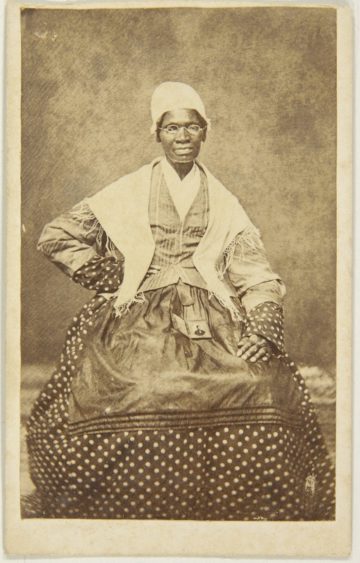
Originally published in the Marina Times San Francisco in September 2016
I feel safe in the midst of my enemies, for the truth is all powerful and will prevail.
— Sojourner Truth
Through Oct. 23, the UC Berkeley Art Museum and Pacific Film Archive present an exhibition showcasing the photographic carte de visite portraits of Sojourner Truth, portraits that she sold at lectures and via U.S. mail as a way to making a living and fund her political activism.
Sojourner Truth, a runaway slave, abolitionist, author, and human rights activist was an original on so many fronts, it’s no surprise she was one of the first Americans to copyright her photos in her own name with the caption, “I sell the Shadow to Support the Substance.” Carte de visite portraits were the standard in calling cards, normally presented during social visits, and usually featured the sitter’s name engraved under a photographic portrait. These portraits were presented on a small format albumen print card made from glass negatives glued onto cardboard mounts, sized 2½ by 4 inches. First invented by French photographer André-Adolphe-Eugène Disdéri, the carte de visite was also inexpensive, and Americans who never could have afforded a portrait were suddenly able to have their likeness memorialized. Combined with the growing usage of the U.S. postal system, the cards appealed to people separated over the vast expanses of the country.
In the modern era of digital photography when anyone can take portraits with a smartphone and post them online at any time, it might be difficult to fully understand what these carte de visite pictures symbolized in the mid 1800s. This commodity was very popular, and they were mostly traded among family members, neighbors, and friends in local areas. Sojourner Truth’s portrait arriving in a household via the U.S. mail must have had a greater impact than a mere shadow. This was a tool she wielded to create a kind of intimacy with her supporters, who then in turn knew they were aiding her progressive causes. This simple transaction formed its own community.
The UC Berkeley Art Museum will host several public programs during the exhibition, including Family Fare: The Story of Sojourner Truth on Sept. 10, comparing and contrasting a series of portraits with guide Shivani Sud. On Sept. 17, a discussion panel considers black activism and photography from the Civil War to the Civil Rights Movement. There are also Sojourner Truth reading groups and a screening of the 2005 film Reparations … Now.